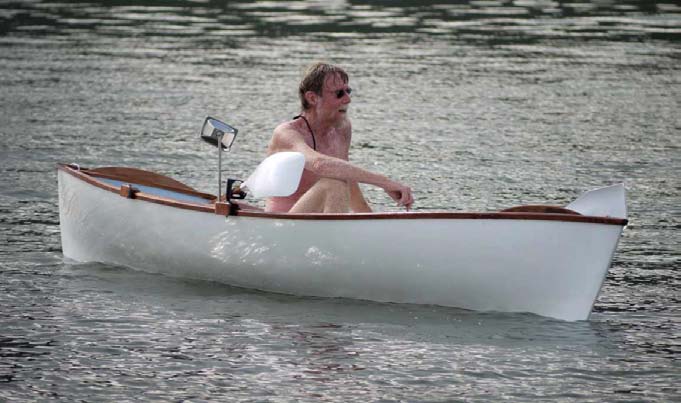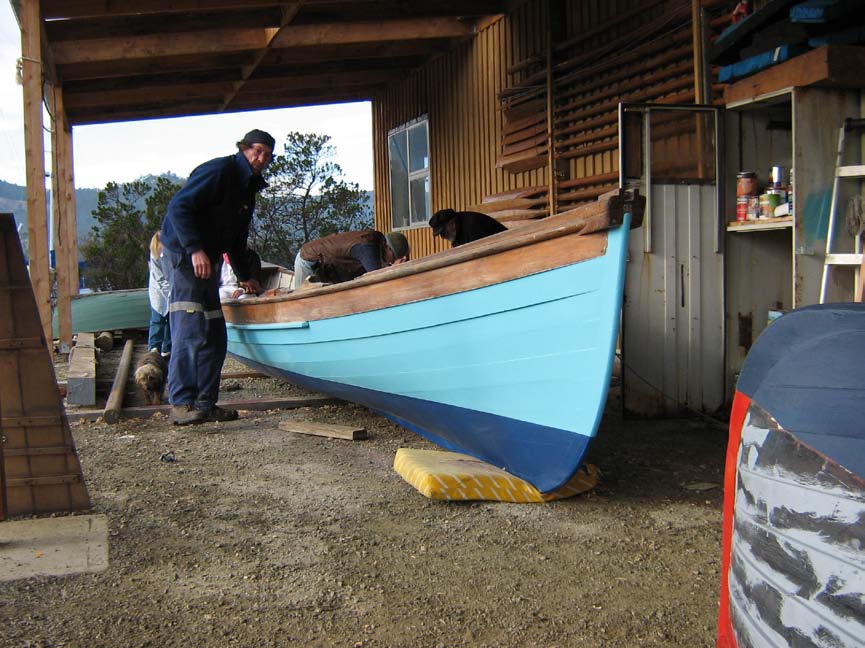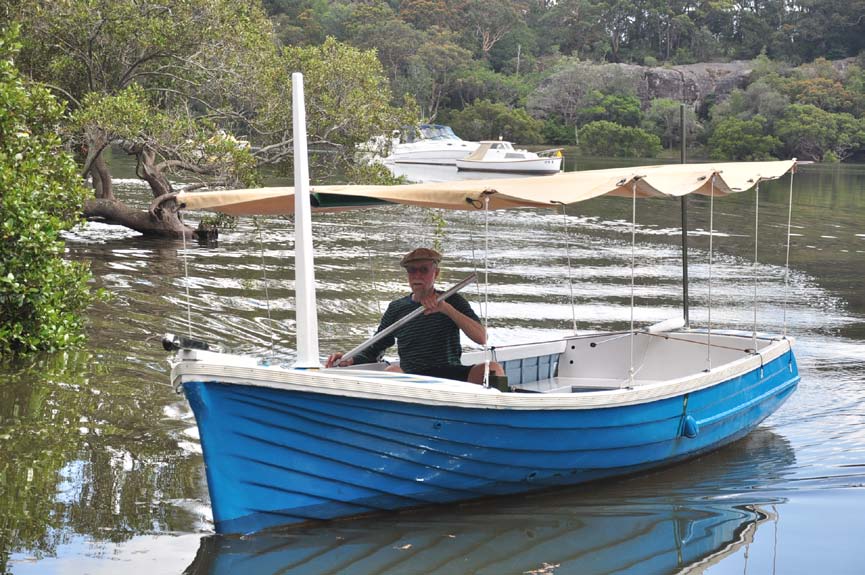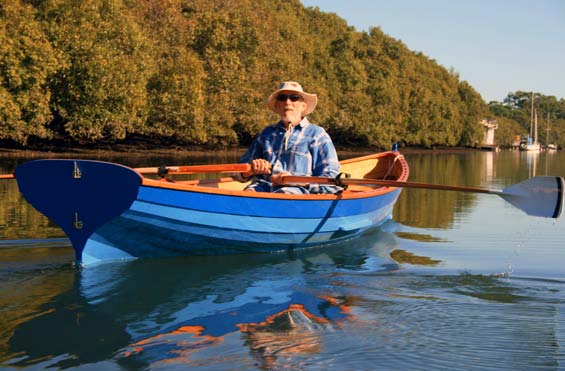I have noticed a recent trend of oars swiveled till the handle is outboard and the blade rests on an inboard seat. Let us call this technique “swiveling oars”. It creates the following problems:
- It deposits salt water on the seat, and this dries to salt crystals, excellent for causing a rash on the bum.
- For boats left thus, on a mooring, facing the current it acts as a kind of barb for careless rowers to run into, such as I have experienced. It is also excellent for catching trailing ropes and fishing lines.
- Left on the beach this way can spear careless walkers in the groin.
- It lacks the aesthetics and symmetry of properly drawn oars.
The proper way of handling oars is to draw the handle inboard and forrard till the blades are up against the oarlocks. On moorings some prefer to do this instead of boating the oars as the latter results in salt water being laid on the seat and the oars rolling around in the boat with each wave.
I have researched terms for this common technique and none of the historic terms describe it. However I would like to propose that this technique be called “drawing oars”.

Now that I have that off my chest let us look at what is meant by “Traditional” seeing as that is what the magazine Ash Breeze is all about. We are now in the twenty first century and what was not traditional in 1970 may well have become traditional now. The Free online dictionary defines traditional as “A set of customs and usages viewed as a coherent body of precedents influencing the present.”
This morning I heard a radio conversation that went thus: “Are you going back to traditional music for the accordion?” Answer; “ But what is traditional music for an accordion? It is still a developing instrument.”
The truly excellent Herreshoff rowboat was designed in 1947 and reached its final form in 1979 at the Hands of John Gardiner and I suppose could not have been called traditional design then, even though traditional clinker methods of construction were used. But always the best timbers glues and fastenings were used as they became available. For example urea formaldehyde glue superseded casein and this was superseded by resorcinol formaldehyde and then epoxy. So what is traditional is a constant improvement of form, function and construction. In addition machine tools (shock horror) replaced hand tools. At around the same time as the Herreshoff boat was designed in 1947, fiberglass came onto the scene. This has now been in use for over 60 years and may now be considered “ traditional”. What should not apply today is the ugly blow molded heavy contraptions made out of polyethylene, polypropylene or ABS plastic. So far these only seem to have made it into canoes but it wont be long, before they graduate.
I notice in our local rag this week a promotion of the modern tender, which has now almost completely replaced the rowing tender. It is a motorized rubber blow up thing, which has become a “status symbol to flaunt alongside your cruiser, to tie outside the taverns, and be seen on board.” And “what greater sight than a bunch of tykes puttering about the anchorage in a tender?” Makes you so proud of your wealth and status, doesn’t it? So this is the enemy of the ancient art of rowing and this is what now makes the rowboat of almost any type “traditional”.
I must agree with Andre de Bardeladem’s (of Middle Path Boats) on the rowing performance of some of the traditional boats of old (in your fall issue). As a sea scout I experienced the sluggish performance using heavy hardwood oars on whaleboats and heavy clinker rowing boats. In 1988 I took part in a reenactment of the 200-year anniversary row of Captain Arthur Phillip to Dangar Island in a whaleboat. Wow what a task that was. This attitude seems to be implied in your fall 2013 issue. After rowing the whaleboat the author commented that “the consensus was, don’t argue with a real whale man”. My very strong friend Anders made a similar comment after rowing the whaleboat made by the Living Boat Trust in Franklin, Tasmania. This type of heavy boat is difficult to maintain, store and row and is destined to turn people away from the activity.

The Herreshoff rowboats we build weigh 72 pounds, can be easily car topped and launched, and are wonderful to row. I own a traditional putt putt that requires a mooring fee and maintenance, license fee, annual anti fouling and general maintenance including, now, replacement of a cracked head on the motor. I love it but the rowboat loves me back by giving me none of this.

In order to be traditional I believe that the rowboat should be aesthetic with elements of wood such as gunwales, backrests, foot stretchers and oars. It should be light for ease of handling, seaworthiness, and rowing. It should be capable of carrying three adults in reasonable comfort and safety, but forget about a sliding seat, traditional all right, but for racing skiffs. Such a boat made out of low maintenance fiberglass will have a much better chance of attracting the public to the fine and fading art of rowing.
I much admire Andre’s work on developing rowing skiffs and gained much from the articles on his website. Particularly I was interested in his comment that boats over 18 feet had too much windage and were difficult to handle in a blow. Anybody tempted to win races with a longer boat should remember this as they may be sacrificing practicality and safety for speed.
Before leaving the matter I must take issue with Greg foster whose Ash Breeze article appeared in Vol. 17, No.3 in 1995. The article is in the excellent book “Building Classic small Craft” by John Gardiner. Greg in his article “The dark side of John Gardiner” refers variously to oars as poverty sticks and agony sticks. If not satire, I would argue the point. I doubt too many people who make rowing equipment are making serious money and I regard my own activities as a paid hobby, but a passion nonetheless. I will agree that some oars are indeed agony sticks. It is one reason I have paid so much attention to the design of oars and rowlocks. I have argued in this magazine that a round oar is the wrong shape and that the traditional flat blade is quite inefficient (articles about these have appeared in Ash Breeze and on my website www.gacooarlocks.com). We oarsmen and women have so little horsepower that efficient rowing equipment is highly desirable. For this reason I use carbon fiber for the blades to enable the compound shape needed for the highest efficiency. This is then painted white to preserve the aesthetic look of the traditional oar.

Notwithstanding all of the above I have to confess that I find magic in the older clinkers and carvels planked over ribs and fastened with copper nails and roves and varnished inside. To me they have a whiff of square-riggers and long gone old salts. However I am old enough to have had experience of these craft when they were used as hire boats and it was rare to find one that did not leak and being waterlogged, quite heavy. It would be a shame if a passion for building these craft died but it would be equally a shame if the more practical, lighter and durable modern classic type designs died. This would make rowing less practical as a modern healthy, environmentally friendly, activity.